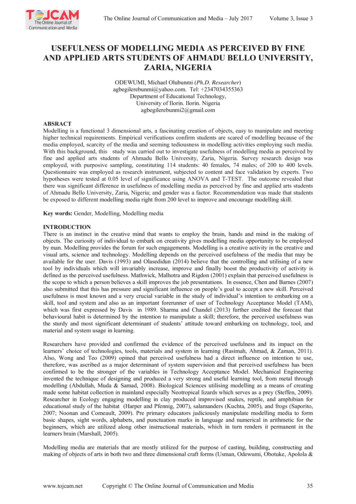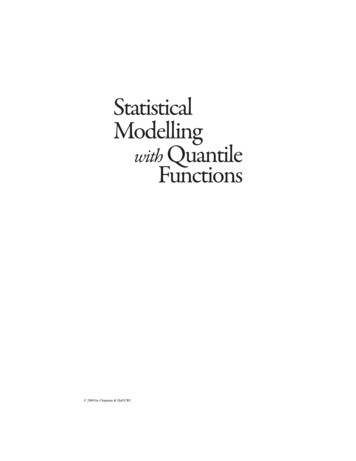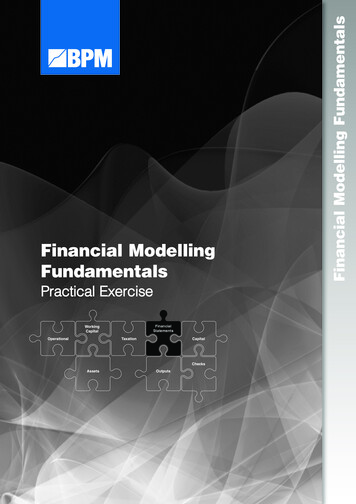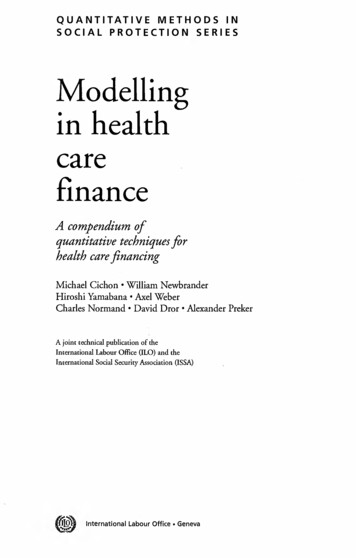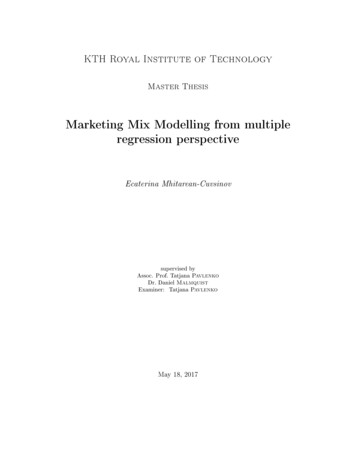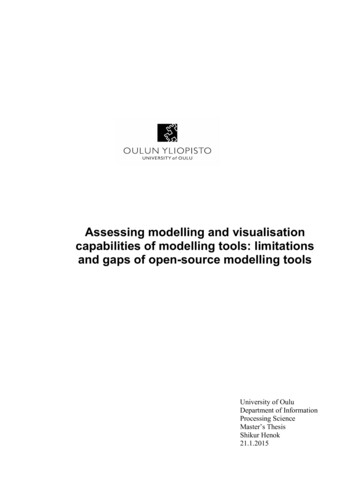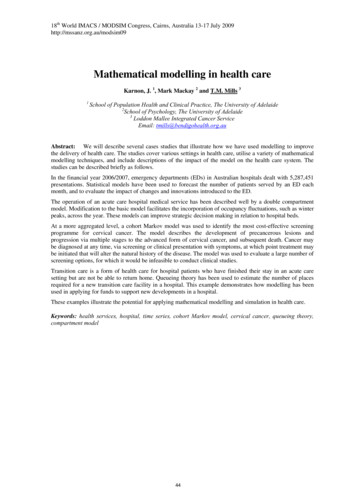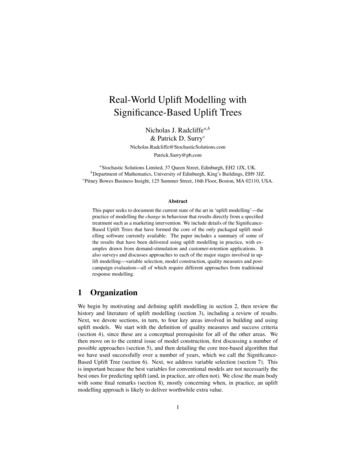
Transcription
Real-World Uplift Modelling withSignificance-Based Uplift TreesNicholas J. Radcliffea,b& Patrick D. trick.Surry@pb.comaStochastic Solutions Limited, 37 Queen Street, Edinburgh, EH2 1JX, UK.Department of Mathematics, University of Edinburgh, King’s Buildings, EH9 3JZ.cPitney Bowes Business Insight, 125 Summer Street, 16th Floor, Boston, MA 02110, USA.bAbstractThis paper seeks to document the current state of the art in ‘uplift modelling’—thepractice of modelling the change in behaviour that results directly from a specifiedtreatment such as a marketing intervention. We include details of the SignificanceBased Uplift Trees that have formed the core of the only packaged uplift modelling software currently available. The paper includes a summary of some ofthe results that have been delivered using uplift modelling in practice, with examples drawn from demand-stimulation and customer-retention applications. Italso surveys and discusses approaches to each of the major stages involved in uplift modelling—variable selection, model construction, quality measures and postcampaign evaluation—all of which require different approaches from traditionalresponse modelling.1OrganizationWe begin by motivating and defining uplift modelling in section 2, then review thehistory and literature of uplift modelling (section 3), including a review of results.Next, we devote sections, in turn, to four key areas involved in building and usinguplift models. We start with the definition of quality measures and success criteria(section 4), since these are a conceptual prerequisite for all of the other areas. Wethen move on to the central issue of model construction, first discussing a number ofpossible approaches (section 5), and then detailing the core tree-based algorithm thatwe have used successfully over a number of years, which we call the SignificanceBased Uplift Tree (section 6). Next, we address variable selection (section 7). Thisis important because the best variables for conventional models are not necessarily thebest ones for predicting uplift (and, in practice, are often not). We close the main bodywith some final remarks (section 8), mostly concerning when, in practice, an upliftmodelling approach is likely to deliver worthwhile extra value.1
Real-World Uplift Modelling with Significance-Based Uplift Trees2Radcliffe & SurryIntroduction2.1Predictive Modelling in Customer ManagementStatistical modelling has been applied to problems in customer management since theintroduction of statistical credit scoring in the early 1950s, when the consultancy thatbecame the Fair Isaac Corporation was formed (Thomas, 2000).1 This was followedby progressively more sophisticated use of predictive modelling for customer targeting,particularly in the areas of demand stimulation and customer retention.As a broad progression over time, we have seen:1. penetration (or lookalike) models, which seek to characterize the customers whohave already bought a product. Their use is based on the assumption that people with similar characteristics to those who have already bought will be goodtargets, an assumption that tends to have greatest validity in markets that are farfrom saturation;2. purchase models, which seek to characterize the customers who have bought ina recent historical period. These are similar to penetration models, but restrictattention to the more recent past. As a result, they can be more sensitive tochanges in customer characteristics across the product purchase cycle from earlyadopters through the mainstream majority to laggards (Moore, 1991);3. ‘response’ models, which seek to characterize the customers who have purchasedin apparent ‘response’ to some (direct) marketing activity such as a piece of direct mail. Sometimes, the identification of ‘responders’ involves a coupon, ora response code (‘direct attribution’), while in other cases it is simply based ona combination of the customer’s having received the communication and purchasing in some constrained time window afterwards2 (‘indirect attribution’).‘Response’ models are normally considered to be more sophisticated than bothpenetration models and purchase models, in that they at least attempt to connect the purchase outcome with the marketing activity designed to stimulate thatactivity.All of these kinds of modelling come under the general umbrella of ‘propensity modelling’.In the context of customer retention, there has been a similar progression, startingwith targeted acquisition programmes, followed by models to predict which customersare most likely to leave, particularly around contract renewal time. Such ‘churn’ or ‘attrition’ models are now commonly combined with value estimates allowing companiesto focus more accurately on retaining value rather than mere customer numbers.1 Thomas reports that David Durand of the US National Bureau of Economic Research was the first tosuggest the idea of applying statistical modelling to predicting credit risk (Durand, 1941).2 More complex inferred response rules are sometime used to attribute particular sales to given marketingtreatments, but these appear to us to be rather hard to justify in most cases.Portrait Technical Report TR-2011-12Stochastic Solutions White Paper 2011
Real-World Uplift Modelling with Significance-Based Uplift Trees2.2Radcliffe & SurryMeasuring Success in Direct Marketing: the Control GroupThe primary goal of most direct marketing is to effect some specific change in customerbehaviour. A common example of this is the stimulation of extra purchasing by a groupof customers or prospects. While there may be subsidiary goals, such as brand awareness and the generation of customer goodwill, most marketing campaigns are primarilyevaluated on the basis of some kind of return-on-investment (ROI) calculation.If we focus, initially, on the specific goal of generating incremental revenue, it isclear that measurement of success is non-trivial, because of the difficulty of knowingwhat level of sales would have been achieved had the marketing activity in questionnot been undertaken. The key, as is well known, is the use of a control group, andit is a well-established and widely recognized best practice to measure the incremental impact of direct marketing activity by comparing the performance of the treatedgroup with that of a valid control group chosen uniformly at random3 from the targetpopulation.2.3The Uplift Critique of Conventional Propensity ModellingWhile there is a broad consensus that accurate measurement of the impact of directmarketing activity requires a focus on incrementality through the systematic and carefuluse of control groups, there has been much less widespread recognition of the need tofocus on incrementality when selecting a target population. None of the approaches topropensity modelling discussed in section 2.1 is designed to model incremental impact.Thus, perversely,most targeted marketing activity today, even when measured on the basisof incremental impact, is targeted on the basis of non-incremental models.It is widely recognized that neither penetration models nor purchase models even attempt to model changes in customer behaviour, but less widely recognized that socalled ‘response’ models are also not designed to model incremental impact. The reason they do not is that the outcome variable4 is necessarily set on the basis of a testsuch as “purchased within a 6-week period after the mail was sent” or the use of somekind of a coupon, code or custom link. Such approaches attempt to tie the purchaseto the campaign activity, either temporally or through a code. But while these providesome evidence that a customer has been influenced by (or was at least aware of) themarketing activity, they by no means guarantee that we limit ourselves to incrementalpurchasers. These approaches can also fail to record genuinely incremental purchasesfrom customers who have been influenced but for whatever reason do not use the relevant coupon or code.For the same reasons that we reject as flawed measurement of the incrementality ofa marketing action through counting response codes or counting all purchases within3 Strictly, the control group does not have to be chosen in this way. It can certainly be stratified, andcan even be from a biased distribution if that distribution is known, but this is rarely done as it complicatesthe analysis considerably. Although we have sometimes used more complicated test designs, for clarity ofexposition, we assume uniform random sampling throughout this paper.4 the dependent variable, or target variablePortrait Technical Report TR-2011-13Stochastic Solutions White Paper 2011
Real-World Uplift Modelling with Significance-Based Uplift TreesRadcliffe & Surrya time window, we must reject as flawed modelling based on outcomes that are notincremental if our goal is to model the change in behaviour that results from a givenmarketing intervention (as it surely should be if our success metric is incremental).A common case worth singling out arises when a response code is associated with adiscount or other incentive. If a customer who has already decided to buy a given itemreceives a coupon offering a discount on that item, it seems likely that in many cases thecustomer will choose to use the coupon. (Indeed, it is not uncommon for helpful salesstaff to point out coupons and offers to customers.) Manifestly, in these cases, the salesare not incremental5 whatever the code on coupon may appear to indicate. Indeed,in this case, not only were marketing costs increased by including the customer, butincremental revenue was reduced—from some perspectives, almost the worst possibleoutcome.2.4The Unfortunately Named ‘Response’ ModelWe suspect that the very term ‘response modelling’ is a significant impediment to thewider appreciation of the fact that so-called ‘response models’ in marketing are notreliably incremental. The term ‘response’ is (deliberately) loaded and carries the unmistakable connotation of causality. At the risk of labouring the point, the OxfordEnglish Dictionary’s first definition (Onions, 1973, p. 1810) of response is:Response. 1. An answer, a reply. b. transf. and fig. An action or feelingwhich answers to some stimulus or influence.While it is unrealistic for us to expect to change the historic and accepted nomenclature, we encourage the term ‘response’ model to be used with care and qualification.As noted before, our preferred term for models that genuinely model the incrementalimpact of an action is an ‘uplift model’, though as we shall see, other terms are alsoused.2.5Conventional Models and Uplift ModelsAssume we partition our candidate population randomly6 into two subpopulations, Tand C. We then apply a given treatment to the members of T and not to C. Consideringfirst the binary case, we denote the outcome O {0, 1}, and here assume that 1 is thedesirable outcome (say purchase).A conventional ‘response’ model predicts the probability that O is 1 for customersin T . Thus a conventional model fitsP (O 1 x; T ),(conventional binary ‘response’ model)(1)5 We are assuming here that the coupon was issued by the manufacturer, who is indifferent as to thechannel through which the item is purchased. A coupon from a particular shop could cause the customer toswitch to that shop, but again the coupon alone does not establish this, as the customer could and might havebought from that shop anyway.6 When we say randomly, we more precisely mean uniformly, at random, i.e. each member of the population is assigned to T or C independently, at random, with some fixed, common probability p (0, 1)Portrait Technical Report TR-2011-14Stochastic Solutions White Paper 2011
Real-World Uplift Modelling with Significance-Based Uplift TreesRadcliffe & Surrywhere P (O 1 x; T ) denotes “the probability that O 1 given that the customer,described by a vector of variables x, is in subpopulation T ”. Note that the control groupC does not play any part of this definition. In contrast, an uplift model fitsP (O 1 x; T ) P (O 1 x; C).(binary uplift model)(2)Thus, where a conventional ‘response’ model attempts to estimate the probability thatcustomers will purchase if we treat them, an uplift model attempts to estimate the increase in their purchase probability if we treat them over the corresponding probabilityif we do not. The explicit goal is now to model the difference in purchasing behaviourbetween T and C.Henceforth, we will not explicitly list the x dependence in equations such as these,but it should be assumed.We can make an equivalent distinction for non-binary outcomes. For example, ifthe outcome of interest is some measure of the size of purchase, e.g, revenue, R, theconventional model fitsE(R T )(conventional continuous ‘response’ model)(3)whereas the uplift model estimatesE(R T ) E(R C)3(continuous uplift model)(4)History & Literature ReviewThe authors’ interest in predicting incremental response began around 1996 while consulting and building commercial software for analytical marketing.7 At that time, themost widely used modelling methods for targeting were various forms of regressionand trees.8 The more common regression methods included linear regression, logisticregression and generalised additive models (Hastie & Tinshirani, 1990), usually in theform of scorecards. Favoured tree-based methods included classification and regression trees (CART; Breiman et al., 1984) and, to a lesser extent, ID3 (Quinlan, 1986),C4.5 (Quinlan, 1993), and AID/CHAID (Hawkins & Kass, 1982; Kass, 1980). Thesewere used to build propensity models, as described in the introduction. It quickly became clear to us that these did not lead to an optimal allocation of direct marketingresources for reasons described already, with the consequence that they did not allowus to target accurately the people who were most positively influenced by a marketingtreatment.We developed a series of tree-based algorithms for tackling uplift modelling, all ofwhich were based on the general framework common to most binary tree-based methods (e.g. CART), but using modified split criteria and quality measures. Tree methods7 TheDecisionhouse software was produced by Quadstone Limited, which is now part of Pitney Bowes.of these classes of methods remain widely used, though they have been augmented by recommendation systems that focus more on product set rather than other customer attributes, using a variety of methods including collaborative filtering (Resnick et al., 1994) and association rules (Piatetsky-Shapiro 1991).Bayesian approaches, particularly Naı̈ve Bayes models (Hand & Yu, 2001), have also grown in popularityover this period.8 BothPortrait Technical Report TR-2011-15Stochastic Solutions White Paper 2011
Real-World Uplift Modelling with Significance-Based Uplift TreesRadcliffe & Surryusually begin with a growth phase employing a greedy algorithm (Cormen et al., 1990).Such greedy algorithms start with the whole population at the root of the tree and thenevaluate a large number of candidate splits, using an appropriate quality measure. Thestandard approach considers a number of splits for each (potential) predictor.9 The bestsplit is then chosen and the process is repeated recursively (and independently) for eachsubpopulation until some termination criterion is met—usually once the tree is large.In many variants, there is then a pruning phase during which some of the lower splitsare discarded in the interest of avoiding overfitting. The present authors outlined ourapproach in a 1999 paper (Radcliffe & Surry, 1999), when we used the term DifferentialResponse Modelling to describe what we now call Uplift Modelling.10 At that point,we did not publish our (then) split criterion, but we now give details of our current, improved criterion in section 6. Other researchers have developed alternative methods forthe same problem independently, unfortunately using different terminology in almostevery case.Various results from the approach described in this paper have been published elsewhere, including: US Bank found that a ‘response’ model was spectacularly unsuccessful for targeting a (physical) mailshot promoting a high-value product to its existing customers. When the whole base was targeted, this was profitable (on the basisof the value of incremental sales measured against a control group), but whenthe top 30% identified by a conventional ‘response’ model was targeted, the result was almost exactly zero incremental sales (and a resulting negative ROI).This was because the ‘response’ model succeeded only in targeting people whowould have bought anyway. An uplift model managed to identify a different30% which, when targeted, generated 90% of the incremental sales achievedwhen targeting the whole population, and correspondingly turned a severely lossmaking marketing activity into a highly successful (and profitable) one (Grundhoefer, 2009).11 A mobile churn reduction initiative actually increased churn from 9% to 10%prior to uplift modelling. The uplift model allowed a 30% subsegment to beidentified. Targeting only that subsegment reduced overall churn from 9% tounder 8%, while reducing spend by 70% (Radcliffe & Simpson, 2008). Theestimated value of this to the provider was 8m per year per million customersin the subscriber base. A different mobile churn reduction initiative (at a different operator) was successful in reducing churn by about 5 percentage points (pp), but an uplift modelwas able to identify 25% of the population where the activity was marginal or9 independentvariableversions of the algorithm were implemented in the Decisionhouse software over the years, andused commercially, with increasing success.11 US Bank also developed an in-house approach to uplift prediction called a matrix model. This was basedon the idea of comparing predictions from a response model on the treated population with a natural buy ratemodel built on a mixed population. Prediction from both models were binned and segments showing highuplift were targeted. This produced a somewhat useful model, but one that was less than half as powerful asa direct, significance tree-based uplift model.10 VariousPortrait Technical Report TR-2011-16Stochastic Solutions White Paper 2011
Real-World Uplift Modelling with Significance-Based Uplift TreesRadcliffe & Surrycounterproductive. By targeting only the identified 75% overall retention was increased by from 5 pp to 6 pp, (i.e. 20% more customers were saved) at reducedcost (Radcliffe & Simpson, 2008). This was also valued at roughly 8m per yearper million customers in the subscriber base.We also published an electronic retail analysis based on a challenge set by Kevin Hillstrom (Radcliffe, 2008) of MineThatData (Hillstrom, 2008).Maxwell et al. (2000), at Microsoft Research, describe their approach to targetingmail to try to sell a service such as MSN. Like us, they base their approach on decisiontrees but they simply build a standard tree on the whole population (treated and control)and then force a split on the treatment variable at each leaf node. The primary limitationwith this approach is that splits in the tree are not chosen to fit uplift; it is simplythe estimation at the end that is adapted. The authors do not compare to a non-upliftalgorithm, but report benefits over a mail-to-all strategy in the range 0.05 to 0.20 perhead.Hansotia & Rukstales (2001, 2002) describe their approach to what they call Incremental Value Modelling, which involves using the difference in raw uplifts in thetwo subpopulations as a split criterion. This, indeed, is a natural approach but hasthe obvious disadvantage that population size is not taken into account, leading to anoveremphasis on small populations with high observed uplift in the training population.Lo (2002) has maintained a long-term interest in what he calls True Lift Modellingwhile working in direct marketing for Fidelity Investments. He developed an approachwhich is based on adding explicit interaction terms between each predictor and thetreatment. Having added these terms he performs a standard regression. To use themodel, he computes the prediction with the treatment variable set to one (indicatingtreatment) and subtracts the prediction from the model with the treatment variable setto zero. Lo has used this approach to underpin direct marketing at Fidelity for a numberof years (Lo, 2005) with good success.Manahan (2005) tackles the problem from the perspective of a cellular phone company (Cingular) trying to target customers for retention activity around contract renewaltime. As Manahan notes, an extra reason for paying attention in this case is that thereis clear evidence that retention activity backfires for some customers and has the neteffect of driving them away. Manahan calls his method a Proportional Hazards approach, and the paper is couched in terms of survival analysis (hence the ‘hazards’language), but on close reading it appears that the core method for predicting upliftis, like Hansotia & Rukstales (2001), the ‘two-model’ approach, i.e. direct subtraction of models for the treated and untreated populations. Manahan uses both logisticregression and neural network models, and finds that in his case the neural approachis more successful. (Manahan creates rolling predictions of customer defection ratesfrom his uplift models and compares these with known survival curves both as a formof validation and an input to model selection.)As well as these published approaches, we have seen many organizations try thenatural approach of modelling the two populations (treated and control) separately andsubtracting the predictions. This has the advantages of simplicity and manifest correctness. Unfortunately, as we discuss in section 5, in our experience, in all but the simplestcases it tends to fail rather badly. (We refer to this as the ‘two-model’ approach to upliftPortrait Technical Report TR-2011-17Stochastic Solutions White Paper 2011
Real-World Uplift Modelling with Significance-Based Uplift TreesRadcliffe & Surrymodelling.)More recently, Larsen (2010) has reported work at Charles Schwab using what hecalls Net Lift Modeling. His approach is much closer to ours in that it fundamentallychanges the quantity being optimized in the fitting process to be uplift (net lift). He doesthis using a modification of the weight of evidence transformation (Thomas, 2000) toproduce the net weight of evidence, which is then used as the basis of fitting using eithera K-Nearest Neighbours approach (Hand, 1981) or a Naı̈ve Bayes approach (Hand &Yu, 2001). Larsen also proposes using a net version of ‘information value’ (the netinformation value) for variable selection.Finally, Rzepakowski & Jaroszewicz (2010) have proposed a tree-based method foruplift modelling that is based on generalizing classical tree-building split criteria andpruning methods. Their approach is fundamentally based on the idea of comparingthe distributions of outcomes in the treated and control populations using a divergencestatistic and they consider two, one based on the Kullback-Leibler divergence and another based on a Euclidean metric. Although we have not performed an experimentalcomparison yet, we note that their approach is designed partly around a postulate stating that if the control group is empty the split criterion should reduce to a classicalsplitting criterion. This does not seem natural to us; a more appropriate requirementmight be that when the response rate in the control population is zero the split criterion should reduce to a classical case. We are also concerned that their proposed splitconditions are independent of overall population size, whereas our experience is thatthis is critical in noisy, real-world situations. Finally, it is troubling that the standarddefinition of uplift (as the difference between treated and control outcome rates) cannotbe used in their split criterion because of an implicit requirement that the measure ofdistribution divergence be convex.4Quality Measures and Success CriteriaGiven a valid control group, computing the uplift achieved in a campaign is straightforward, though subject to relatively large measurement error. Assessing the performanceof an (uplift) model is more complex.We have found the uplift equivalent of a gains curve, as shown in Figure 1, to bea useful starting point when assessing model quality (Radcliffe, 2007; Surry & Radcliffe, 2011). Such incremental gains curves are similar to conventional gains curvesexcept that they show an estimate of the cumulative incremental impact on the verticalaxis where the conventional gains curve shows the cumulative raw outcome.If we have predetermined a cut-off (e.g. 20%), we can use the uplift directly asa measure of model quality: in this case, Model 1 is superior12 at 20% target volumebecause it delivers an estimated 450 incremental sales against the estimated 380 incremental sales delivered by Model 2. At target volumes above 40%, the situationreverses.12 For simplicity, we are not specifying, here, whether this is training or validation data, nor are we specifying error bars, though we would do so in practice, giving more weight to validation performance and takinginto account estimated errors.Portrait Technical Report TR-2011-18Stochastic Solutions White Paper 2011
Real-World Uplift Modelling with Significance-Based Uplift TreesRadcliffe & SurryCumulative Extra SalesAn Incremental Gains Chart1000Model 1Model 2800Random Targeting60040020000%20%40%60%80%100%Proportion of population targetedFigure 1: This incremental gains curve shows the effect of targeting differentproportions of the population with two different models. In each case, peopleare chosen in descending order of quality as ranked by the model in question.The vertical axis shows an estimate, in this case, of the number of incremental sales achieved. This estimate is produced by comparing the cumulativepurchase rate, targeting by model score, in the treated and control populations(section 4.1). The vertical axis can alternatively be labelled ‘uplift’, and measured in percentage points. The diagonal shows the effect of random targeting.Note that using Model 2, more incremental sales are achieved by targeting80% of the population than by targeting the whole; this is because of negativeeffects in the last two deciles. In cases where the focus is on revenue or value,rather than conversion, the vertical axis is modified to show an estimate of thecumulative incremental sales value, rather than the volume.Portrait Technical Report TR-2011-19Stochastic Solutions White Paper 2011
Real-World Uplift Modelling with Significance-Based Uplift TreesRadcliffe & SurryGiven cost and value information, we can determine the optimal cutoff for eachmodel and choose the one that leads to the highest predicted campaign profit. Figure 2is derived directly from the incremental gains curve by applying cost and value information, illustrated here with the cost of treating each 1% of the population set to 1,000and the profit contribution from each incremental sale set to 150. Using these figures,we can go further and say that Model 2 is better in the sense that it allows us to delivera higher (estimated) overall campaign profit (c. 70,000 at 60%, against a maximum ofslightly over 60,000 at 40% for Model 1), if that is the goal.13Since Model 1 performs better than Model 2 at small volumes while Model 2 performs better than Model 1 (by a larger margin) at higher target volumes, we mightborrow the notion of dominance from multi-objective optimization (Louis & Rawlins, 1993), and say that neither model dominates the other (i.e. neither is better at allcutoffs).Notwithstanding the observation that different models may outperform each otherat different target volumes, it is useful to have access to measures that summarizeperformance across all possible target volumes. Qini measures (Radcliffe, 2007) dothis, and we will outline them below after a few introductory points.4.1Segment-based vs. Pointwise Uplift Estimates: Non-AdditivityThe core complication with uplift modelling lies in the fact that we cannot measure theuplift for an individual because we cannot simultaneously treat and not treat a singleperson. For this reason, developing any useful quality measure based on comparingactual and observed outcomes at the level of the individual seems doomed to failure.Given a valid treatment-control structure, we can, however, estimate uplift for different segments, provided that we take equivalent subpopulations in each of the treatedand control and that those subpopulations are large enough to be meaningful. Thisincludes the case of a population segmented by model score. Thus it is legitimate forus to estimate the uplift for customers with scores in the range (say) 100–200 by comparing the purchase rates of customers with scores in this range from the treated andcontrol populations.In going down this route, however, we need to be aware that uplift estimates arenot, in general, additive (see Table 1). This is because of unavoidable variation in theprecise proportions of treated and control customers in arbitrary subsegments.144.2Qini MeasuresQini measures are based on the area under the incremental gains curve (e.g. Figure 1).This is a natural generalization of the gini coefficient, which though more commonlydefined with reference to the area under a receiver-operator characteristic (ROC) curve,can equivalently be defined with reference to the conventional gains curve. Because theincremental gains curve is so intimately linked to the qini measure, we tend to refer to13 This statement assumes that the uplift estimates are accurate. In general, uplift cannot be estimated asaccurately as a purchase rate can be.14 a phenomenon related to Simpson’s ‘Paradox’ (Simpson, 1951)Portrait Techn
Statistical modelling has been applied to problems in customer management since the introduction of statistical credit scoring in the early 1950s, when the consultancy that became the Fair Isaac Corporation was formed (Thomas, 2000).1 This was followed by progressively more sophisticated use of predictive modelling for customer targeting,

